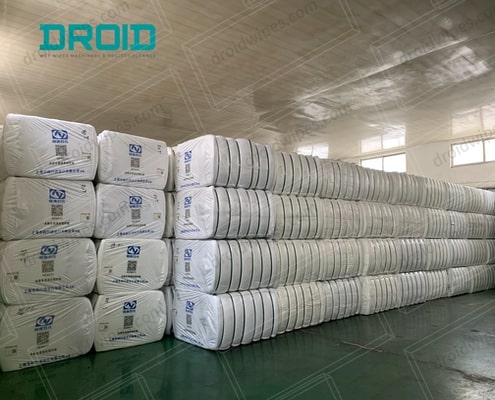1. Leverage Advanced Automation
Utilizing sophisticated automation is crucial in the current competitive industrial environment to optimize production processes and maximize profitability. Automation technologies have seen substantial advancements, providing unparalleled levels of efficiency and accuracy. Investing in cutting-edge automated gear may significantly transform the whole manufacturing process for wet wipes manufacturers, including everything from the processing of raw materials to the final step of packaging.
Automated systems can efficiently and accurately perform repeated activities, hence decreasing reliance on manual labor and lowering the occurrence of human mistakes. Robotic arms may be used for many operations, including material feeding, cutting, folding, and packing, to guarantee constant quality and output. These wet wipes machines can operate continuously, resulting in a substantial boost in production capacity and throughput.
Moreover, contemporary automation systems often come integrated with sophisticated sensors and artificial intelligence (AI) capabilities. These intelligent systems can continuously monitor many factors, including temperature, humidity, and machine performance, in real time. Through ongoing analysis of this data, they may enhance production conditions and adapt operations to sustain optimal efficiency. AI-powered automation may anticipate possible problems before they result in expensive periods of inactivity, enabling proactive maintenance and minimizing unforeseen interruptions.
The use of automation in the production of wet wipes not only increases efficiency but also improves the quality of the products. Adhering to a consistent and accurate approach in operations results in a reduction in faults and an increase in customer satisfaction. Moreover, automation has the potential to decrease material waste by enabling machines to be programmed to use resources more effectively, hence leading to additional cost savings.
Overall, using sophisticated automation is a strategic decision for wet wipes makers that want to maintain competitiveness and optimize financial gains. Wet wipes manufacturers may achieve improved production efficiency, consistently high product quality, and reduced operating costs by investing in state-of-the-art automated equipment and intelligent systems. This investment eventually leads to company development and success.
2. Implement Predictive Maintenance
When it comes to producing wet wipes, the most important factor is the dependability of the equipment. This is crucial for ensuring smooth operations and optimizing profits. Implementing predictive maintenance is a proactive approach that uses technology to continuously monitor the state of equipment in real-time, accurately forecasting any malfunctions before they happen. This method greatly decreases the amount of time that the production line is not functioning and lowers the expenses associated with maintenance, guaranteeing that the production line functions at its highest level of effectiveness.
Predictive maintenance employs sensors and IoT (Internet of Things) devices that are connected to essential components of equipment. The sensors consistently gather data on many performance measures, including vibration, temperature, and pressure. The data is then subjected to advanced analytics and machine learning algorithms to detect trends and abnormalities that might suggest an imminent collapse. By identifying these first indicators, maintenance may be planned, therefore avoiding unforeseen failures and expensive urgent repairs.
Predictive maintenance has advantages that go beyond the avoidance of equipment faults. Additionally, it enables the optimization of maintenance resources. Conventional maintenance programs sometimes depend on predetermined time intervals, resulting in superfluous maintenance tasks or overlooked problems. Predictive maintenance, in contrast, guarantees that maintenance is executed just when necessary, hence maximizing the use of manpower and spare components. By using this focused strategy, not only are expenses reduced, but the durability of the equipment is also prolonged, resulting in an optimal return on investment.
Moreover, predictive maintenance enhances the total efficiency of manufacturing. By eliminating the occurrence of unexpected periods of inactivity, the production line can consistently achieve the desired level of output, ensuring that delivery dates are met and the likelihood of production delays is minimized. This level of dependability improves client contentment as orders are promptly executed and continuously adhere to quality criteria.
Another notable benefit of predictive maintenance is its capacity to connect with other digital transformation projects seamlessly. By integrating predictive maintenance with automation systems, it is possible to establish a production environment that is both extremely responsive and flexible. Through the use of predictive insights, wet wipes machines can adapt their activities autonomously, hence improving efficiency and minimizing the probability of failures.
Ultimately, the use of predictive maintenance in the production of wet wipes is a crucial approach to enhance operational efficiency and maximize financial gains. Wet wipes manufacturers may proactively mitigate possible difficulties, save downtime, and prolong the lifespan of their equipment by using innovative technology to monitor and evaluate machinery performance. This strategy enhances both efficiency and cost-effectiveness while also bolstering the reliability and resilience of the wet wipes manufacturing process.
3. Optimize Supply Chain Management
Efficient supply chain management is a fundamental method for optimizing profitability in the production of wet wipes. A functional supply chain assures the cost-efficient sourcing of raw materials, adherence to manufacturing schedules, and timely delivery of completed goods to clients. Wet wipes manufacturers may achieve substantial cost reductions, enhance operational efficiency, and increase customer satisfaction by improving supply chain procedures.
Attaining complete visibility across the whole supply chain is a crucial step in enhancing supply chain management. Utilizing sophisticated supply chain management software enables instantaneous monitoring of supplies, inventory levels, and manufacturing progress. Having this level of information enables wet wipes manufacturers to promptly anticipate and address any interruptions, such as delays in the supply of raw materials or shifts in demand. The use of real-time data allows for well-informed decision-making, guaranteeing optimal allocation of resources and the maintenance of production schedules.
Accurately predicting demand is another crucial element. By using data analytics and machine learning algorithms, wet wipes manufacturers may examine past sales data, market trends, and external variables in order to forecast future demand. Precise demand forecasting facilitates the maintenance of ideal inventory levels, preventing both excessive stock and stock shortages. By maintaining this equilibrium, the expenses associated with storing inventory are minimized, while simultaneously guaranteeing a seamless manufacturing process devoid of any disruptions caused by insufficient materials.
Efficiently managing logistics is crucial for optimizing the supply chain. Efficient logistics management includes the process of carefully finding the most optimal transportation routes, combining goods, and selecting dependable carriers. Through the optimization of these factors, wet wipes manufacturers can decrease transportation expenses and minimize delivery durations. Furthermore, using just-in-time (JIT) inventory methods may further optimize efficiency. Just-in-time (JIT) methodology decreases the need for extensive stockpiles by aligning material shipments with production timetables, hence eliminating expenses related to storage and waste.
Supplier relationship management is a crucial aspect to consider. Establishing robust alliances with dependable suppliers guarantees a steady supply of superior-grade supplies. Collaborative partnerships provide more effective bargaining of pricing, conditions, and delivery periods, resulting in cost reductions. Wet wipes manufacturers can collaborate with suppliers to create novel materials or procedures that improve the quality of their products and decrease the expenses associated with manufacturing.
Implementing sustainability principles in supply chain management may result in enduring financial benefits and enhanced brand image. Wet wipes manufacturers may attract environmentally sensitive customers and minimize their environmental impact by procuring products from sustainable and ethical sources. Adopting green logistics techniques, such as employing fuel-efficient transportation and minimizing packaging waste, may effectively bolster sustainability initiatives.
Furthermore, the use of technology is essential for optimizing supply chain operations. By using technology like blockchain, transparency and traceability may be improved, guaranteeing that every stage of the supply chain is closely observed and can be verified. This level of openness facilitates the maintenance of quality standards and adherence to rules, hence minimizing the likelihood of recalls and the accompanying expenses.
Ultimately, the optimization of supply chain management in the manufacture of wet wipes is crucial to maximize profit and attain operational excellence. Wet wipes manufacturers may improve the efficiency and resilience of their supply chain by improving visibility, correctly predicting demand, optimizing logistics, cultivating strong supplier relationships, and using innovative technology. These enhancements not only save expenses but also amplify consumer contentment and facilitate sustainable company expansion.
4. Focus on Energy Efficiency
Maximizing profit in wet wipes manufacturing processes relies heavily on improving energy efficiency. Decreasing energy use not only reduces operating expenses but also supports environmental sustainability, which may improve a company’s brand and attract environmentally sensitive clients. Wet wipes manufacturers may gain substantial cost savings and operational enhancements by adopting energy-efficient practices and technology.
The first step is to carry out a thorough energy audit to improve energy efficiency. An energy audit entails evaluating the present energy use across the whole production plant, pinpointing places where energy is being squandered, and suggesting improvements. This audit should include assessing the efficacy of equipment, lighting, heating, ventilation, and air conditioning (HVAC) systems. An energy audit provides valuable information that may be used to design a focused energy savings plan.
One of the most effective methods to decrease energy use is by investing in energy-efficient gear. Contemporary industrial machinery is specifically engineered to be very energy-efficient, using cutting-edge technology to carry out tasks with low energy use. Variable frequency drives (VFDs) may be used on motors to modify their speed and torque by the individual demands of each operation, hence minimizing energy inefficiency. In addition, the use of energy-efficient compressors and pumps may greatly reduce the amount of energy needed for industrial operations.
Implementing an upgrade to the facility’s lighting system is an additional efficient action to take. Substituting conventional incandescent or fluorescent lights with energy-efficient LED lighting may lead to significant energy savings. LED lights have a lower power consumption, and an extended lifetime, and provide superior lighting, which enhances safety and productivity in the workplace. By using motion sensors and intelligent lighting controls, energy savings may be further optimized since lights will only be used when required.
Efficiently optimizing HVAC systems is essential for ensuring a pleasant and energy-efficient production environment. Performing routine maintenance on HVAC systems, such as cleaning filters and inspecting for leaks, guarantees optimal performance and efficiency. Integrating intelligent thermostats and sophisticated control systems may enhance temperature regulation, resulting in decreased energy use. In addition, enhancing the insulation of the building may prevent the transfer of heat, resulting in reduced energy consumption by HVAC systems.
Renewable energy sources provide a viable and long-lasting alternative for decreasing energy expenses and minimizing carbon emissions. By implementing on-site installation of solar panels or wind turbines, it is possible to produce renewable energy that may partially compensate for the energy requirements of the facility, hence reducing its reliance on non-renewable sources. Although the initial expenditure may be substantial, the long-term cost savings and environmental advantages make it a viable option to investigate. In addition, several governments provide incentives and tax advantages to encourage the use of renewable energy, hence increasing the economic feasibility of these initiatives.
Employee participation and training are crucial factors in attaining energy efficiency objectives. Providing workers with knowledge about the significance of energy conservation and engaging them in efforts to save energy helps cultivate a sustainable culture. Implementing basic measures such as powering off equipment and lights when not in use, adjusting production schedules to reduce energy consumption during high-demand periods, and promoting energy-efficient habits may lead to substantial energy conservation.
Continuous insights into energy consumption trends may be obtained by monitoring and controlling energy use using modern energy management systems. These systems can monitor energy use in real time, detect areas of inefficiency, and propose appropriate measures for improvement. Through the analysis of this data, producers may make well-informed choices and take initiatives to enhance energy efficiency consistently.
Ultimately, prioritizing energy efficiency in the production of wet wipes is crucial for minimizing expenses and improving environmental sustainability. Effective techniques include conducting energy audits, investing in energy-efficient equipment and lighting, improving HVAC systems, leveraging renewable energy sources, involving staff, and deploying sophisticated energy management systems. Wet wipes manufacturers may achieve substantial cost savings, enhance operational efficiency, and contribute to a more sustainable future by giving priority to energy efficiency.
5. Innovate with Raw Materials
Innovatively utilizing raw materials is a crucial approach to enhance the efficiency of wet wipes production operations and achieve maximum profitability. The selection of raw materials has a dual effect on both the cost of manufacturing and the quality and environmental consequences of the end product. Through the exploration of novel and inventive materials, wet wipes manufacturers have the potential to decrease expenses, improve product functionality, and attract a growing number of environmentally aware customers.
An important domain of advancement is the use of biodegradable and sustainable materials. Conventional wet wipes often include non-biodegradable synthetic fibers such as polyester, which contribute to environmental pollution. Wet wipes manufacturers may reduce the environmental effect of wet wipes by transitioning to natural fibers like bamboo, cotton, or cellulose-based materials. These alternatives disintegrate more readily, making them more eco-friendly. These sustainable materials are often obtained from renewable resources, which corresponds to the increasing customer desire for environmentally friendly goods and enhances the marketability of the brand.
Another inventive strategy is the integration of recyclable materials. Utilizing recycled fibers in the manufacturing of wet wipes may substantially save expenses related to raw materials and minimize the environmental impact. Recent advancements in recycling technology have enabled the production of recycled fibers of exceptional quality that exhibit comparable performance to virgin materials. This not only facilitates cost reduction but also promotes the concepts of circular economy, which include minimizing waste and effectively reusing resources.
Investigating novel material combinations may also result in enhanced product functionality. The use of various fibers and materials may augment the durability, absorbent capacity, and tactile comfort of wet wipes. For example, combining natural fibers with a small proportion of synthetic fibers might provide the necessary strength for certain uses while yet maintaining environmental advantages. These hybrid materials may be customized to fulfill precise product specifications, providing a competitive advantage in the market.
There is great potential for innovation in the chemical compositions utilized in wet wipes. Creating innovative formulations using natural and hypoallergenic components may meet the needs of customers with sensitive skin or particular health issues. Ingredients such as aloe vera, chamomile, and essential oils may enhance the value of a skincare product by offering supplementary advantages for the skin. By reducing or removing dangerous substances such as parabens, phthalates, and alcohol, the safety of the wipes may be improved. This will allow them to fulfill more stringent regulatory criteria and enhance customer confidence.
Collaborating with suppliers of raw materials may significantly enhance the progress of innovation. Wet wipes manufacturers may create unique materials customized to their individual requirements by working closely with suppliers. This may include collaborating on the development of novel fibers, conducting experiments with alternative materials, or enhancing the performance and cost-effectiveness of current ones. Additionally, these collaborations may provide a consistent and reliable source of superior resources, therefore mitigating the potential for scarcity and price volatility.
The significance of sustainability certifications and eco-labels is growing in the marketplace. Wet wipes manufacturers may tap into new market niches and cater to the needs of environmentally concerned customers by using certified sustainable materials. Certifications such as FSC (Forest Stewardship Council) for wood-based materials or GOTS (Global Organic Textile Standard) for organic fibers assure ethical sourcing and manufacturing procedures, therefore bolstering brand confidence.
The significance of innovation in packing materials is equivalent. Wet wipes may be enhanced by using sustainable packaging solutions, such as biodegradable or recyclable materials, which align with their eco-friendly characteristics. Implementing advancements in package design, such as minimizing material use or integrating reusable elements, may effectively diminish waste and decrease packaging expenses.
Ultimately, using novel materials is crucial for enhancing the production of wet wipes and increasing financial gain. Wet wipes manufacturers can improve product quality, decrease expenses, and meet the changing expectations of consumers and regulators by utilizing biodegradable and sustainable materials, integrating recycled fibers, experimenting with new material combinations, creating mild chemical formulations, collaborating with suppliers, and obtaining sustainability certifications. These advancements not only help to a more environmentally friendly future but also provide a competitive edge in the ever-changing wet wipes industry.
6. Streamline Product Design
Efficiently designing products is a crucial approach to enhance the production operations of wet wipes and achieve maximum profitability. Wet wipes manufacturers may achieve cost reduction, improved productivity, and the creation of high-quality goods that satisfy customer demands by streamlining designs and prioritizing critical features. This technique not only enhances profitability but also enhances the sustainability and competitiveness of the industrial business.
A key advantage of optimizing product design is the decrease in costs. Streamlined designs sometimes need a reduced quantity of materials, hence reducing the expenses associated with raw resources. For example, by optimizing the dimensions and form of wet wipes, it is possible to reduce the amount of waste generated during the cutting process. Moreover, the use of standardized components across many product lines helps reduce the expenses associated with procurement and streamline inventory management. Wet wipes manufacturers may achieve cost-effective production of high-quality items by prioritizing crucial characteristics and removing superfluous parts.
Another notable benefit is the improved efficiency of manufacturing. Streamlined product designs provide more efficient and expeditious manufacturing processes, resulting in decreased production time and reduced labor expenses. For instance, by creating wet wipes that have a uniform size and fold pattern, the assembly process may be made more efficient. This enables wet wipes machines to function at increased rates while requiring fewer modifications. This level of consistency decreases the probability of mistakes and the need for redoing tasks, hence enhancing overall efficiency. Furthermore, streamlined designs are often more amenable to automation, hence increasing the possibility of integrating cutting-edge production technology.
Streamlining product design also enhances quality control. By reducing the number of components and simplifying the assembly operations, the chances of faults and inconsistencies are minimized. Dependability is essential for maintaining superior product standards and guaranteeing customer pleasure. Ensuring a consistent level of product quality establishes confidence in the brand and has the potential to enhance consumer loyalty and encourage repeat purchases.
Consumers are placing more importance on sustainability, and a simplified product design may help achieve environmental objectives. Wet wipes manufacturers may decrease their environmental impacts by minimizing material use and waste generation. Streamlined designs often use a reduced amount of resources and produce a diminished amount of waste, hence conforming to sustainable manufacturing principles. In addition, including recyclability or biodegradability in the design helps amplify the environmental advantages of the goods, attracting environmentally aware customers and adhering to more stringent regulatory standards.
Innovation is essential for creating efficient product designs. Wet wipes manufacturers have the opportunity to investigate novel materials and technologies in order to develop designs that are more efficient. For instance, using sophisticated materials with enhanced absorbency or durability might decrease the required quantity of material per wipe, leading to a more efficient and cost-effective solution. By soliciting input from users and doing comprehensive testing, one may pinpoint the most efficient design enhancements, guaranteeing that the items satisfy market expectations while preserving simplicity.
Effective coordination across design, engineering, and manufacturing teams is crucial for achieving efficient optimization. Engaging production teams at an early stage in the design process may guarantee that the designs are both feasible and capable of being manufactured. This collaborative effort across different departments aids in the identification of possible problems and areas for enhancement prior to the manufacturing stage, hence minimizing the need for expensive redesigns and modifications.
Customization and modularity are advantageous approaches to efficient product design. Providing customers with the ability to personalize their products by selecting certain features or configurations may enhance product attractiveness without adding complexity to the production process. Modular designs facilitate the development of several goods by using shared components, hence streamlining manufacturing processes and decreasing expenses. This adaptability enables the effective expansion of manufacturing to satisfy fluctuating market needs.
Ultimately, optimizing product design is a strategic methodology that has a multitude of advantages for makers of wet wipes. Wet wipes manufacturers may improve their operations and maximize profit by prioritizing crucial characteristics, minimizing material consumption, improving production efficiency, and promoting sustainability. To boost the efficiency of streamlined designs, it is beneficial to embrace innovation, encourage cross-functional cooperation, and use customization and modularity. These endeavors not only enhance the financial performance but also contribute to a more competitive and environmentally-friendly manufacturing operation, assuring long-term success in the ever-changing wet wipes industry.
7. Enhance Workforce Training
Improving staff training is an essential element in improving the production processes of wet wipes and boosting profitability. An adept staff is better equipped to operate sophisticated equipment, execute efficient methodologies, and uphold stringent quality requirements. Investing in extensive training programs enhances operational efficiency and cultivates a culture of ongoing development and innovation.
First and foremost, offering consistent and focused training guarantees that staff possess the necessary skills to effectively use cutting-edge technology and machines. Given the growing dependence on advanced automation and complex technology in wet wipes production, personnel must possess the necessary skills to operate these systems. Training programs should include both the technical aspects of equipment functioning as well as the concepts of troubleshooting and maintenance. By providing staff with these abilities, wet wipes manufacturers can minimize the amount of time lost due to operational mistakes and guarantee that production proceeds seamlessly and effectively.
Furthermore, training improves safety measures and mitigates the likelihood of workplace accidents. Manufacturing settings provide potential dangers, and incorrect use of machines or substances might result in severe harm. Comprehensive safety training programs provide personnel with knowledge and skills about the most effective methods for managing equipment, materials, and emergency scenarios. This measure not only ensures the safety and well-being of workers but also reduces the likelihood of expensive interruptions and legal obligations. An atmosphere that prioritizes safety enhances employee morale and productivity by instilling a sense of security and recognition.
Furthermore, worker training facilitates quality control and ensures product uniformity. Quality assurance training programs educate personnel on fault identification, quality standards comprehension, and remedial measures implementation. When workers possess a high level of understanding of the significance of quality and get enough training to uphold it, the probability of manufacturing faulty items diminishes considerably. Ensuring a consistent level of quality improves customer satisfaction and decreases the expenses related to returns and rework.
Enhanced personnel training also fosters a culture of continual improvement, which is another significant advantage. Training programs must include modules on lean manufacturing concepts, problem-solving methodologies, and process optimization. Promoting employee engagement in identifying inefficiencies and proposing enhancements may result in the development of new solutions and the optimization of production processes. This proactive strategy not only enhances efficiency but also actively involves workers, fostering a sense of being essential contributors to the company’s achievements.
Training is also beneficial for retaining and developing talent. Employees are more inclined to remain with a firm that prioritizes and allocates resources toward their professional development and progression. Implementing training programs that provide options for career progression may enhance work satisfaction and mitigate employee turnover rates. Proficient and seasoned staff are very important resources, and keeping them on board contributes to the stability and effectiveness of the workforce.
Implementing cross-training programs for workers is an additional very beneficial method. Wet wipes manufacturers may enhance operational flexibility and resilience by providing training to personnel to undertake numerous jobs in the production process. Employees who have been trained in many roles may substitute for colleagues who are not present, therefore minimizing the effects of manpower shortages and guaranteeing continued output. This adaptability also enables more effective distribution of the workforce, particularly during times of high output.
Utilizing contemporary training techniques may improve the efficiency of worker training programs. Using e-learning platforms, simulation software, and virtual reality (VR) may provide dynamic and captivating training experiences. These technologies enable workers to engage in skill practice inside a regulated setting, therefore strengthening their learning and enhancing their self-assurance. In addition, online training courses provide flexibility, allowing workers to study at their speed and according to their schedule.
Ultimately, improving staff training is crucial for optimizing the production processes of wet wipes and boosting profitability. Consistent and thorough training programs enhance technical expertise, ensure safety, maintain quality control, and foster employee involvement. Wet wipes manufacturers may enhance their operational efficiency and ensure consistent product quality by cultivating a culture that emphasizes continual improvement and innovation. Investing in worker training not only enhances the company’s financial performance but also fosters a safer, more motivated, and more skilled staff. By using contemporary training techniques and cross-training programs, wet wipes manufacturers can guarantee that their workers have the necessary skills and knowledge to effectively navigate the challenges of a constantly evolving and fiercely competitive sector.
8. Utilize Data Analytics
Data analytics has become a transformative technique in the pursuit of optimizing wet wipes production operations and maximizing profitability. Wet wipes manufacturers may enhance their operations, detect inefficiencies, and make well-informed choices to promote improvements and save costs by using data effectively. Data analytics converts unprocessed data into usable insights, enabling more accurate and efficient control of industrial operations.
Data analytics offers a holistic perspective of the wet wipes manufacturing process by gathering and analyzing data from different production phases. This includes information on machine performance, manufacturing output, failure rates, energy usage, and other relevant statistics. State-of-the-art analytics systems can efficiently handle this immense volume of data in real-time, providing valuable insights that were previously unachievable. Through constant monitoring of these parameters, producers may promptly detect deviations from the standard and implement remedial measures to prevent small errors from escalating into significant difficulties.
Data analytics offers a significant benefit in terms of enhancing manufacturing efficiency. Predictive analytics, a subfield of data analytics, uses historical data and machine learning algorithms to anticipate forthcoming patterns and results. For instance, predictive maintenance models may use data from machines to forecast the probable occurrence of component failure, enabling proactive scheduling of repair. This minimizes unforeseen periods of inactivity and prolongs the operational life of machinery, leading to substantial financial savings and continuous production efficiency.
Furthermore, data analytics improves quality control by detecting patterns and correlations that may not be easily noticeable via human examination. Wet wipes manufacturers may identify the underlying reasons for quality problems by examining data on defect rates and production factors. This may include establishing a correlation between problems and certain machine configurations, batches of raw materials, or environmental circumstances. By using this information, wet wipes manufacturers may strategically apply specific enhancements to minimize defect rates, optimize product quality, and ultimately boost customer happiness.
Data analytics is essential in supply chain management. Wet wipes manufacturers may enhance their supply chain operations by examining data pertaining to inventory levels, supplier performance, and logistics. For example, demand forecasting models use previous sales data, industry trends, and other pertinent elements to anticipate future demand. Wet wipes manufacturers may effectively manage their inventory levels, hence minimizing the expenses related to excessive stock or insufficient stock. Furthermore, analytics may assist in identifying the most optimal transportation routes and timetables, hence reducing logistical expenses and enhancing delivery efficiency.
Data analytics may result in significant cost reductions in the field of energy efficiency. Through the process of monitoring and evaluating energy consumption trends, wet wipes manufacturers can discover specific locations where energy is being inefficiently used and then apply methods to decrease utilization. Analytics may provide insights into the energy consumption patterns of certain devices, highlighting increased use during specific periods or under specific situations. Equipped with this knowledge, wet wipes manufacturers may modify their operations to maximize energy use, such as arranging energy-intensive jobs to be performed during non-peak hours or updating equipment that is not efficient.
Data analytics plays a crucial role in workforce management. Wet wipes manufacturers may boost labor efficiency by examining data on employee performance, productivity, and absenteeism to detect patterns and execute initiatives. Analytics may be used to ascertain the optimal training programs, recognize top-performing staff for advancement, and organize shifts to enhance efficiency. By using a data-driven strategy, the workforce is optimized to its maximum capacity, hence enhancing total operational efficiency.
In addition, data analytics promotes innovation by offering valuable insights into product development and market trends. Wet wipes manufacturers may discern upcoming trends and consumer preferences by scrutinizing customer feedback, market data, and sales performance. This allows them to create novel items or enhance current ones to better satisfy market needs. In addition, analytics may be used to evaluate the possible consequences of introducing new materials, technologies, or processes. This evaluation can guide investment choices and mitigate the risks associated with innovation.
To summarize, the use of data analytics is crucial for improving the production processes of wet wipes and achieving maximum profitability. Wet wipes manufacturers may improve their production efficiency, quality control, supply chain operations, energy efficiency, and labor management by converting data into actionable insights. Data analytics plays a crucial role in both enhancing operational efficiency and facilitating strategic decision-making and innovation, so assuring sustained competitiveness and success in the ever-changing wet wipes industry.
9. Embrace Lean Manufacturing Principles
Adopting lean manufacturing concepts is an effective method for streamlining the production processes of wet wipes and boosting profitability. Lean manufacturing aims to reduce waste and increase value by optimizing production processes, enhancing efficiency, and cultivating a culture of ongoing improvement. Wet wipes manufacturers may achieve cost reduction, improved product quality, and better responsiveness to market needs by using lean concepts.
An essential principle of lean manufacturing is the identification and eradication of waste, which refers to any action that does not provide value to the client. Within the wet wipes manufacturing industry, waste may manifest in several ways, such as surplus inventory, excessive production, idle periods, wasteful transportation, ineffective procedures, flaws, and untapped human potential. Through a systematic approach to detecting and resolving different forms of waste, wet wipes manufacturers may develop manufacturing systems that are both more efficient and cost-effective. Reducing surplus inventory has the benefit of decreasing storage expenses and mitigating the possibility of obsolescence. Similarly, enhancing process efficiency may result in shorter production durations and decreased labor expenditures.
Value stream mapping is an essential technique in lean manufacturing that aids in visualizing the movement of materials and information across the production process. Through the systematic delineation of each stage of the procedure, producers may discern points of congestion, unnecessary repetitions, and potential areas for improvement. This holistic perspective facilitates more informed decision-making and assists in prioritizing areas for lean efforts. For example, the process of value stream mapping may uncover that a certain machine often leads to delays, which would then force a decision to spend on maintenance or upgrade to more dependable equipment.
Kaizen, commonly referred to as continuous improvement, is another key idea of lean manufacturing. This idea promotes a culture where all workers, regardless of their position, are encouraged to actively pursue and implement improvements in their work processes. Within a lean manufacturing setting, frequent, gradual modifications are implemented, resulting in substantial, enduring enhancements. Promoting a culture of ongoing improvement not only improves productivity but also fosters employee engagement, making people feel appreciated and included in the company’s achievements.
Standardized work is a crucial aspect of lean manufacturing since it guarantees that procedures are executed consistently and with maximum efficiency. Wet wipes manufacturers may achieve a reduction in variability, error minimization, and the assurance of high-quality output by creating comprehensive standard operating procedures (SOPs) for each activity. Standardized work facilitates the training of new personnel and the expansion of operations. For instance, in the manufacture of wet wipes, using standardized procedures for mixing cleaning solutions, folding and packing, and quality inspection methods might result in more uniform product quality and less need for rework.
Just-in-time (JIT) production is a fundamental aspect of lean manufacturing. The objective of Just-in-Time (JIT) is to manufacture goods or provide services precisely as required, at the exact time they are needed, and in the precise amount required. This strategy decreases the amount of extra inventory and lowers the expenses related to keeping and handling surplus supplies. For wet wipes manufacturing, Just-in-Time (JIT) may be achieved by carefully coordinating production schedules with demand predictions and supplier deliveries. This ensures that supplies are received precisely when they are required for production. This minimizes expenses associated with storing goods and allows for the allocation of funds to other projects.
Lean manufacturing places significant emphasis on the need to keep a tidy and well-organized work environment, which is often referred to as the 5S methodology: Sort, Set in order, Shine, Standardize, and Sustain. An efficiently structured workplace raises productivity, minimizes the probability of mistakes, and boosts safety measures. Within a wet wipes production plant, this may include arranging tools and supplies for convenient retrieval, consistently sanitizing workstations and equipment, and upholding conspicuous signs and labels to avert any potential misunderstanding.
The success of lean manufacturing heavily relies on the crucial factors of employee participation and empowerment. Wet wipes manufacturers may enhance their operations by engaging workers in problem-solving and decision-making activities since they possess valuable personal experience and ideas that can contribute to driving changes. Providing staff with training in lean concepts and methods, such as root cause analysis and problem-solving approaches, enables them to acquire the necessary skills to recognize inefficiencies and execute efficient solutions.
Ultimately, adopting lean manufacturing concepts is crucial for improving the production processes of wet wipes and boosting profitability. Wet wipes manufacturers may achieve greater operational efficiency and cost-effectiveness by prioritizing waste reduction, continuous improvement, standardized work, just-in-time manufacturing, and staff participation. Lean manufacturing improves operational efficiency and fosters a culture of innovation and continuous improvement, guaranteeing long-term competitiveness and success in the ever-changing wet wipes industry.
10. Invest in R&D
Allocating resources to research and development (R&D) is an essential approach for enhancing wet wipes manufacturing processes and increasing financial gain. Research and development (R&D) fosters innovation, enabling producers to create novel goods, enhance current ones, and uncover more effective production methods. By cultivating a climate of originality and ongoing enhancement, investments in research and development may result in notable competitive benefits, reduced expenses, and improved market standing.
An important advantage of investing in research and development (R&D) is the creation of cutting-edge goods that satisfy changing customer needs. Within the wet wipes industry, there is a growing demand from customers for goods that possess certain qualities, such as being biodegradable, having improved performance, or containing soft formulas suitable for sensitive skin. Research and development efforts might prioritize the creation of novel wet wipe goods that specifically appeal to these inclinations, therefore expanding into untapped market niches and enhancing sales. Creating a range of biodegradable wet wipes using sustainable materials, such as bamboo or recycled fibers, may appeal to environmentally aware customers and set the business apart in a competitive market.
Research and development (R&D) is essential for enhancing the quality and performance of current goods. By doing thorough testing and experimentation, research and development teams may discover ways to improve product characteristics such as absorbency, strength, and texture. These enhancements have the potential to result in increased customer happiness and loyalty, as well as decreased rates of returns and complaints. In addition, research and development (R&D) may assist in enhancing the compositions of wet wipes to guarantee their effectiveness while maintaining a gentle nature. This will ensure that the wet wipes fulfill both regulatory standards and customer demands for safety and efficacy.
Investing in research and development may lead to major advantages in the field of process innovation. Through the process of conducting research and implementing innovative manufacturing methods, wet wipes manufacturers have the potential to enhance operational effectiveness, save expenses, and mitigate the generation of unnecessary materials. For instance, research and development endeavors may concentrate on enhancing the use of primary resources, refining manufacturing methods for greater efficiency, or integrating cutting-edge automation technology. These advancements have the potential to optimize operations, reduce manufacturing costs, and boost throughput, eventually improving profitability.
Research and development (R&D) may also result in the identification of novel materials that provide economic or operational benefits. Researching alternate fibers and formulations may lead to the development of raw materials that are both more sustainable and cost-effective. Wet wipes manufacturers may enhance their competitive advantage by either creating their exclusive materials or finding new alternatives, hence reducing reliance on conventional sources. These materials may provide higher performance attributes, such as improved softness or durability, which can further distinguish the product in the market.
Collaborative research and development (R&D) endeavors have the potential to enhance and magnify the advantages of innovation. Collaborating with academic institutions, research groups, or other enterprises may provide novel viewpoints and specialized knowledge to the development process. These partnerships have the potential to expedite the rate of innovation and broaden the range of research endeavors. For example, a maker of wet wipes may engage in a collaboration with a university to investigate cutting-edge material science or form a partnership with a technology business to incorporate Internet of Things (IoT) technologies into their wet wipes manufacturing procedures. These collaborations have the potential to generate revolutionary advancements that propel the sector towards progress.
Investing in research and development (R&D) also aids in achieving regulatory compliance and sustainability objectives. With the increasing stringency of rules regarding product safety and environmental effects, research and development (R&D) endeavors can guarantee that goods not only meet but also surpass these criteria. Conducting research into environmentally friendly materials, packaging that can decompose naturally, and manufacturing techniques that are sustainable may assist wet wipes manufacturers in staying ahead of regulatory obligations and attracting environmentally aware customers. Implementing this proactive strategy not only reduces the danger of non-compliance but also improves the company’s reputation and attractiveness to the market.
Moreover, expenditures in research and development may cultivate a culture of innovation inside the firm. Promoting employee involvement in idea generation and research initiatives may result in a more enthusiastic and driven team. The organization may foster a pervasive culture of innovation, which can lead to ongoing enhancements and motivate people to approach problem-solving and efficiency with innovative thinking.
Ultimately, allocating resources to research and development is crucial for enhancing the efficiency of wet wipes production methods and maximizing financial gains. R&D plays a crucial role in gaining a competitive edge and reducing costs via the creation of new goods, enhancement of current offers, streamlining processes, exploration of novel materials, collaboration, and adherence to regulations. Wet wipes manufacturers may secure long-term success and dominance in the ever-changing wet wipes industry by cultivating a culture that promotes innovation and ongoing enhancement.











